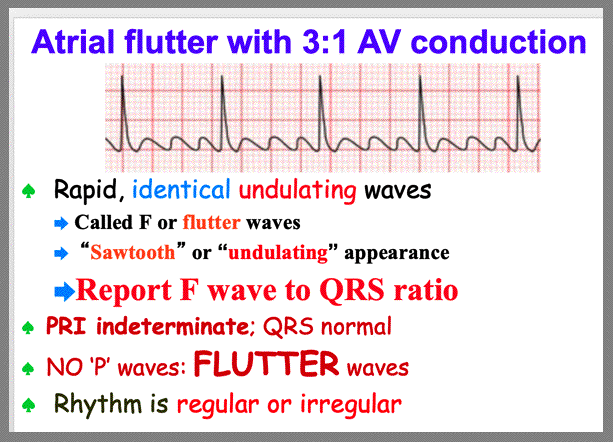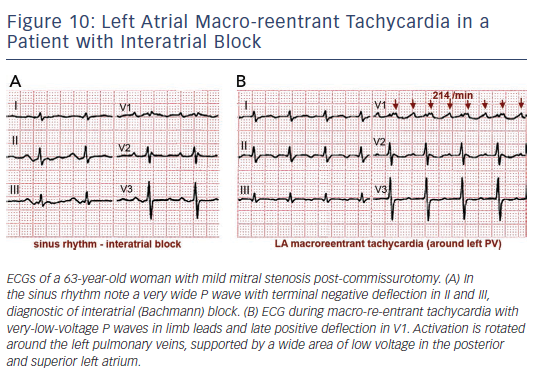

Rate control is often difficult due to the regularity and usually slow rate of the tachycardia. Right atrial atypical flutter is associated with atrial sutures and patches used for complex congenital heart disease surgery or following surgical atriotomy. Upper loop re-entry (right atrium) - positive F waves in the inferior leads and negative, flat, or barely positive F waves in lead I. Lower loop re-entry (around the inferior vena cava) - negative F waves in the inferior leads Left atrial flutters – variable morphology - positive or isoelectric F waves in V1 - often positive F waves in the inferior leads II, III, aVF Right atrial flutters – negative F wave in V1 P waves are absent - F waves are regular, but there may be an isoelectric appearance between F waves - No clear F wave morphology - atrial scar can alter conduction velocity and direction The most frequent left atrial flutters are perimitral, peripulmonary veins, septal, roof and posterior wall macro reentry. Atypical left atrial flutters – left atrial macroreentry (anatomic obstacle like the mitral annulus), post-ablation AF (incomplete ablation lines from either a transvenous catheter ablation or a surgical Maze procedure).Atypical right atrial flutters - lesion macroreentrant tachycardia (an atriotomy scar or suture line can act as an obstacle to conduction and create reentry – most common) or non-atriotomy related right atrial flutter (areas of low voltage in the right atrium).atrial flutter is a type of supraventricular tachycardia which originates from a macro-re-entrant circuit in the atria that does not involve the CTI (cavotricuspid isthmus) with ECG patterns differing from the counterclockwise and clockwise typical flutter What's the difference between atrial flutter and atrial fibrillation? (n.d.).

medical-conditions/blood-heart-circulation/atrial-flutter/treatments.html Atrial flutter versus atrial fibrillation in a general population: Differences in comorbidities associated with their respective onset. diseases-conditions/atrial-fibrillation/diagnosis-treatment/treatment/txc-20164944 Cardiology teaching package: Atrial flutter.Obstructive sleep apnea in patients with typical atrial flutter: Prevalence and impact on arrhythmia control outcome. Patient-Resources/Heart-Diseases-Disorders/Atrial-Flutter You can learn more about how we ensure our content is accurate and current by reading our editorial policy. Healthline has strict sourcing guidelines and relies on peer-reviewed studies, academic research institutions, and medical associations. Still, ablation therapy is typically only used when medications can’t control the conditions. However, ablation is usually considered the best treatment for atrial flutter. Medication is usually the first treatment for AFib. The surgeon makes small cuts or burns in the heart’s atria. Maze surgery: Maze surgery is an open-heart surgery. After this type of ablation, you’ll need a pacemaker to maintain a regular rhythm. The AV node connects the atria and ventricles. NOACs include dabigatran (Pradaxa), rivaroxaban (Xarelto), apixaban (Eliquis) and edoxaban (Savaysa).Įlectrical cardioversion: This procedure uses an electrical shock to reset the rhythm of your heart.Ĭatheter ablation: Catheter ablation uses radiofrequency energy to destroy the area inside your heart that’s causing the abnormal heart rhythm.Ītrioventricular (AV) node ablation: This procedure uses radio waves to destroy the AV node. NOACs are now recommended over warfarin unless the person has moderate to severe mitral stenosis or has an artificial heart valve. blood-thinning medications such as non-vitamin K oral anticoagulants (NOACs) or warfarin (Coumadin) to prevent stroke or heart attack.amiodarone, propafenone, and flecainide to convert the rhythm back to normal.



 0 kommentar(er)
0 kommentar(er)
